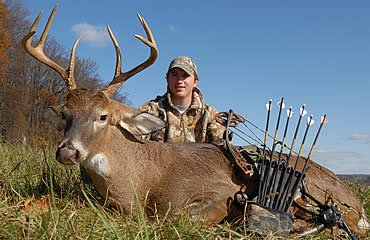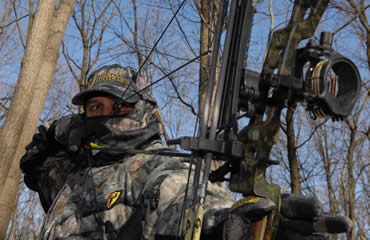By P.J. Reilly
Learn to keep your cool in the heart-pounding seconds surrounding a shot.
By the time I reached my buddy J.R., he was a wreck. His face was ghost white, his hands were shaking and his voice was stammering — pretty typical symptoms for someone who had just arrowed his first buck and subsequently been bitten by the bowhunting bug.
J.R. said he'd just shot the fine 8-pointer he'd spotted from his field-edge stand a week earlier. “I n-n-know it was the same d-d-deer,” he stuttered with excitement.
“Okay, okay, calm down,” I told him. “Before we go running after it, tell me about your shot. Was the buck perfectly broadside, or was he quartering one way or the other?”
“I’m not sure.”
“How did the buck react when your arrow hit?”
“I can’t remember.”
“Which trail did he take when he ran out of the field?”
“I don’t know.”
J.R.’s excitement was infectious. I wanted nothing more than to go diving into the woods to help my buddy recover his first bow-killed buck. But with daylight fading, no sign on the ground at the point of impact, no arrow and no reliable information about the shot, we had no choice but to let that deer go overnight.
 Early the following morning, J.R., his dad and I went back out. J.R. and I were trying to find where the buck had left the field, while his dad walked through the woods to see if he might stumble across the buck. He wasn’t gone 15 minutes when he hollered, “Here he is!”
Early the following morning, J.R., his dad and I went back out. J.R. and I were trying to find where the buck had left the field, while his dad walked through the woods to see if he might stumble across the buck. He wasn’t gone 15 minutes when he hollered, “Here he is!”
J.R. and I plowed through the brush at a dead sprint and spotted the gut-shot 8-pointer lying at his dad’s feet. We recovered the deer, but the meat was spoiled because we had been forced to leave the buck overnight in warm temperatures.
Later, J.R.’s dad and I took him aside and told him it was understandable to come unglued when shooting his first buck, but in the future, he needed to keep his head in the game.
“Bowhunting is 90 percent mental and 10 percent physical,” said Rob Kaufhold, an avid whitetail bowhunter and former U.S. Olympic Archery Team member who now owns Lancaster Archery Supply in Pennsylvania. “You can be the best shot in the world, but if you can’t keep your head together, you’re not going to be a very successful bowhunter.”
Bowhunting is a game of decisions. How far away is that buck? When can I draw and where is the best shooting lane? Should I start tracking now, or wait?
And these decisions have to be made under tremendous stress.
“A lot of people think the best competition archers ought to be the best bowhunters,” Kaufhold said. “But competition archery and bowhunting are incredibly different. Yes, there is a huge amount of stress involved in both, but everything is very controlled in an archery tournament. All you have to do is block out everything around you and shoot.
“Bowhunting is done in poor light, you have to watch out for obstacles in your shooting lane, and you have to be totally aware of what’s going on around you, because there might be more than one deer.”
Kaufhold compared bowhunting to being a wide receiver in the NFL.
“You have to judge the trajectory of the ball to time your jump, then make the catch while making sure you know where the sideline is and if there are any defenders waiting to hit you and knock the ball away,” he said. “You have to have tremendous concentration on the ball, but you also have to be aware of your surroundings.” Same thing goes for bowhunting.
“You have to know where every twig is in the shooting lane,” he said. “You have to know what other deer around you are doing so you don’t alert them, but you have to concentrate on the one deer you’re going to shoot. Then, once you do get a shot, you get that big adrenaline surge. You still have to stay focused to watch the deer’s reaction and where it runs. The game isn’t over the instant you release your arrow.”
Keeping your head in a bowhunt starts when you climb into your stand or blind. Do as much work as possible before a trophy buck shows up so you have less to worry about when that rack is dipping through the brush at 30 yards.
Find your shooting lanes. Determine where you can and cannot shoot. Once you’ve identified those lanes, range objects within them with a rangefinder, or, if you don’t have one, do it mentally.
 “If you know ahead of time it’s 32 yards to that tree off to your left, then you don’t have to think about the distance if a deer shows up there,” Kaufhold said.
“If you know ahead of time it’s 32 yards to that tree off to your left, then you don’t have to think about the distance if a deer shows up there,” Kaufhold said.
Any bowhunter who’s ever encountered a deer while on stand knows the adrenaline rush that comes the instant you see one. Every deer evokes that surge, and if that deer is a big buck, the surge is even stronger. It’s a wonderful feeling. It’s why we bowhunt. Whether that sudden rush of adrenaline causes you to freak out and blow the hunt, or you become a steely-eyed predator who cannot be deterred, is up to you.
Hunters, like athletes, need to realize that the nervous energy brought on by an adrenaline surge is normal, said Dr. Gary Bennett, a sports psychologist in the athletics department at Virginia Tech University.
“A lot of times, athletes will feel that nervousness and think something is wrong,” he said. “Then they start focusing on that, rather than the task at hand, and that’s often when they fail to perform.”
A technique Bennett teaches Virginia Tech athletes to calm trembling hands and knees is to tighten the muscles in the shaking areas for a few seconds and then release them.
“If you’re a bowhunter and your hand is shaking, clench your fist real tight and then relax it a few times,” he said. “The shaking is caused by tension in the muscles, and if you increase the tension even more, a lot of times, you can stop the shaking that would impede your performance.”
Kaufhold believes bowhunters can ward off the shakes by visualizing a buck approaching the stand, entering a shooting lane, and then seeing themselves make a killing shot. “It’s a way of preparing for something mentally before it actually happens,” he said.
Dr. David Yukelson, director of sports psychology at Penn State University, agrees. “We often ask our athletes to visualize themselves performing at their best,” he said. “We want them to remember those times when they are in complete control and confident. And the more vivid you can make the visualization, the better prepared you’ll be.
“Go through a number of if-then scenarios,” he said. “If this happens, then I should do this. We even have our athletes visualize situations in which they mess up, just so they can think about what they need to do to get back on track and regain their composure.”
When a buck shows up for real and the adrenaline starts pumping, Kaufhold said it’s important for hunters to ward off tunnel vision.
“It’s very easy to lock on to that buck and forget everything else,” he said. “But you have to be aware of your surroundings. If there are other deer around, you have to be aware of where they are and what they’re doing so you don’t spook them.”
A big mental hurdle for hunters is prematurely hanging a buck’s rack on the wall at home.
“Guys see a big rack and immediately start thinking about how jealous they’re going to make their buddies when they show off the antlers of the deer that’s coming to them,” Kaufhold said. “And they haven’t even drawn the bow yet.”
That’s a common mistake for athletes, according to Bennett.
“Whether you’re taking a shot at a deer or standing on the free-throw line to win the basketball game, you can’t think about the enormity of the situation,” he said. “You have to remember the mechanics of what you’re doing are no different in this situation than they are when you’re relaxed at practice.”
Kaufhold recommends bowhunters focus on the fundamentals of shooting as they draw and take aim.
“Instead of thinking about how much you want to get your hands on that rack, focus on where you want your arrow to hit to make a good shot,” he said. “Turn that shot at a trophy into target practice.”
In the second round of the 2010 NCAA men’s basketball tournament, the University of Maryland Terrapins and Michigan State University Spartans battled down to the wire. With six seconds remaining in the game, a Maryland player sunk a basket that put the underdog Terps up 83-82. But after the basket, Maryland’s defense relaxed. The Spartans raced down the court, and one of their players launched a three-point shot at the buzzer to give Michigan State the 85-83 win.
“Maryland acted like the game was over after they scored, and that cost them the game,” Bennett said.
“Mentally, that basket they scored was so huge, they lost focus.” Athletes and hunters have to recognize when the game is truly over and train their minds to stay sharp until then, Bennett said. “Visualize the end in your mind and tell yourself ahead of time that you can’t stop until then,” he said.
As J.R. learned on the hunt at the beginning of this article, a bowhunt doesn’t end until you’re holding a buck’s rack in your hands. When you take a shot, your focus and concentration must continue to be sharp so you can collect information critical to recovering the deer.
Exactly where was the deer standing when you shot? How did it react? Which way did it run? Where’s the last spot you saw it before it disappeared? Did you hear a crash?
The answer to each question will help you develop a recovery plan that might indicate it’s okay to take up the trail by yourself, or it might call for you to back out, wait a few hours and return with help.
“When you shoot, there’s a huge rush of adrenaline,” Kaufhold said. “A lot of guys say they don’t really start to shake until after they shoot. But you’ve got to stay focused until the deer is out of sight and out of earshot.”
And once that time comes, Kaufhold said, it’s okay to enjoy the moment. “Take some time and feel that rush,” he said. “It’s a great feeling. It’s why we do this. So don’t try to suppress the rush because you think you shouldn’t get excited. Get excited!”
If you’ve ever played an organized sport, odds are your coach at some point has told you to keep your head in the game. Heed those words in the deer woods this fall.
Read Recent Articles:
• Hunt Like a Lady: No longer novelties in the woods, the ladies are taking some really big bucks!
• Food Plots: What’s Right for You? Think about your goals to determine what to plant.
• Bucks on a Shoestring: You don’t have to spend big bucks to hunt out of state for big bucks.
This article was published in the August 2010 edition of Buckmasters Whitetail Magazine. Subscribe today to have Buckmasters delivered to your home.